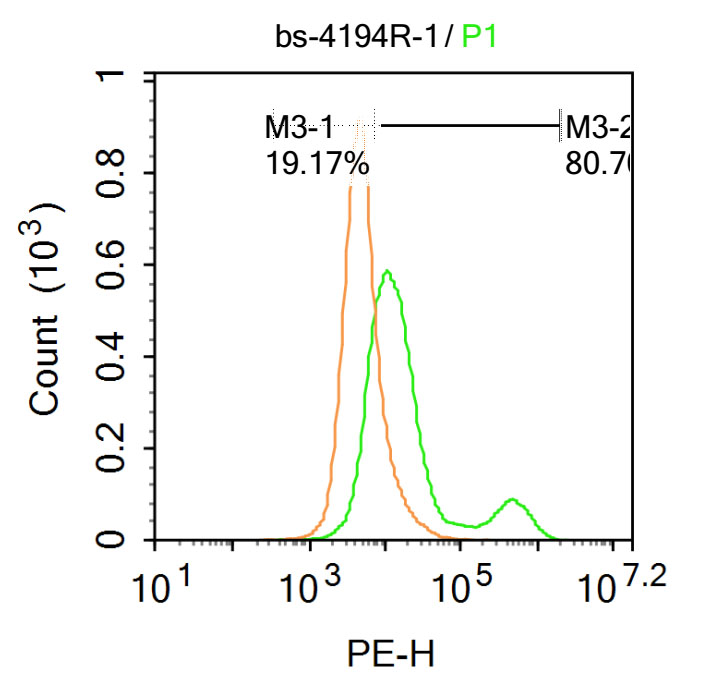
Rabbit Anti-CD167b/DDR2 antibody
DDR 2; DDR2; DDR 2; CD167b antigen; Cell migration inducing protein 20; Discoidin domain containing receptor 2; Discoidin domain receptor 2; Discoidin domain receptor family member 2v Hydroxyaryl protein kinase; MIG20a; Migration inducing gene 16 protein;
View History [Clear]
Details
Product Name CD167b/DDR2 Chinese Name 盘状结构域受体蛋白2抗体 Alias DDR 2; DDR2; DDR 2; CD167b antigen; Cell migration inducing protein 20; Discoidin domain containing receptor 2; Discoidin domain receptor 2; Discoidin domain receptor family member 2v Hydroxyaryl protein kinase; MIG20a; Migration inducing gene 16 protein; Neurotrophic tyrosine kinase; Neurotrophic tyrosine kinase receptor related 3v NTRKR 3; NTRKR3v Receptor protein tyrosine kinase TKTv Receptor related 3; TKTv TYRO 10; TYRO10; Tyrosine kinase receptor related to neurotrophic TRK; Tyrosine protein kinase TYRO 10; Tyrosine protein kinase TYRO10; Tyrosylprotein kinase; Discoidin domain-containing receptor 2; CD167 antigen-like family member B; Discoidin domain-containing receptor tyrosine kinase 2; Neurotrophic tyrosine kinase, receptor-related 3; Receptor protein-tyrosine kinase TKT; DDR2_HUMAN. literatures Research Area Cardiovascular Neurobiology Channel protein The cell membrane受体 Immunogen Species Rabbit Clonality Polyclonal React Species Human, Mouse, (predicted: Rat, Chicken, Dog, Pig, Cow, Horse, Rabbit, ) Applications WB=1:500-2000 ELISA=1:5000-10000
not yet tested in other applications.
optimal dilutions/concentrations should be determined by the end user.Theoretical molecular weight 92kDa Detection molecular weight 110-120 kDa Cellular localization The cell membrane Form Liquid Concentration 1mg/ml immunogen KLH conjugated synthetic peptide derived from human CD167b: 245-350/855 <Extracellular> Lsotype IgG Purification affinity purified by Protein A Buffer Solution 0.01M TBS(pH7.4) with 1% BSA, 0.03% Proclin300 and 50% Glycerol. Storage Shipped at 4℃. Store at -20 °C for one year. Avoid repeated freeze/thaw cycles. Attention This product as supplied is intended for research use only, not for use in human, therapeutic or diagnostic applications. PubMed PubMed Product Detail Receptor tyrosine kinases (RTKs) play a key role in the communication of cells with their microenvironment. These molecules are involved in the regulation of cell growth, differentiation, and metabolism. In several cases the biochemical mechanism by which RTKs transduce signals across the membrane has been shown to be ligand induced receptor oligomerization and subsequent intracellular phosphorylation. This autophosphorylation leads to phosphorylation of cytosolic targets as well as association with other molecules, which are involved in pleiotropic effects of signal transduction. RTKs have a tripartite structure with extracellular, transmembrane, and cytoplasmic regions. This gene encodes a member of a novel subclass of RTKs and contains a distinct extracellular region encompassing a factor VIII-like domain. Alternative splicing in the 5' UTR results in multiple transcript variants encoding the same protein. [provided by RefSeq, Jul 2008].
Function:
Tyrosine kinase that functions as cell surface receptor for fibrillar collagen and regulates cell differentiation, remodeling of the extracellular matrix, cell migration and cell proliferation. Required for normal bone development. Regulates osteoblast differentiation and chondrocyte maturation via a signaling pathway that involves MAP kinases and leads to the activation of the transcription factor RUNX2. Regulates remodeling of the extracellular matrix by up-regulation of the collagenases MMP1, MMP2 and MMP13, and thereby facilitates cell migration and tumor cell invasion. Promotes fibroblast migration and proliferation, and thereby contributes to cutaneous wound healing.
Subunit:
Binds hydroxyproline-rich sequence motifs in fibrillar, glycosylated collagen, such as the GQOGVMGFO motif, where O stands for hydroxyproline. Interacts with SRC. Interacts (tyrosine phosphorylated) with SHC1.
Subcellular Location:
Cell membrane; Single-pass type I membrane protein.
Tissue Specificity:
Detected in osteocytes, osteoblastic cells in subchondral bone, bone lining cells, tibia and cartilage. Detected at high levels in heart and lung, and at low levels in brain, placenta, liver, skeletal muscle, pancreas, and kidney.
Post-translational modifications:
N-glycosylated.
Tyrosine phosphorylated in response to collagen binding. Phosphorylated by SRC; this is required for activation and subsequent autophosphorylation on additional tyrosine residues.
DISEASE:
Defects in DDR2 are the cause of spondyloepimetaphyseal dysplasia short limb-hand type (SEMD-SL) [MIM:271665]. A bone disease characterized by short-limbed dwarfism, a narrow chest with pectus excavatum, brachydactyly in the hands and feet, a characteristic craniofacial appearance and premature calcifications. The radiological findings are distinctive and comprise short long bones throughout the skeleton with striking epiphyses that are stippled, flattened and fragmented and flared, irregular metaphyses. Platyspondyly in the spine with wide intervertebral spaces is observed and some vertebral bodies are pear-shaped with central humps, anterior protrusions and posterior scalloping.
Similarity:
Belongs to the protein kinase superfamily. Tyr protein kinase family. Insulin receptor subfamily.
Contains 1 F5/8 type C domain.
Contains 1 protein kinase domain.
SWISS:
Q16832
Gene ID:
4921
Database links:Entrez Gene: 4921 Human
Entrez Gene: 18214 Mouse
Omim: 191311 Human
SwissProt: Q16832 Human
SwissProt: Q62371 Mouse
Unigene: 275757 Human
Unigene: 593833 Human
Unigene: 229249 Mouse
Unigene: 224678 Rat
Product Picture
Primary Antibody (green line): Rabbit Anti-CD167b/DDR2 antibody (SL4194R)
Dilution: 1μg /10^6 cells;
Isotype Control Antibody (orange line): Rabbit IgG .
Secondary Antibody : Goat anti-rabbit IgG-PE
Dilution: 1μg /test.
The cells were incubated in 5%BSA to block non-specific protein-protein interactions for 30 min at at room temperature .Cells stained with Primary Antibody for 30 min at room temperature. The secondary antibody used for 40 min at room temperature. Acquisition of 20,000 events was performed.
References (0)
No References
Bought notes(bought amounts latest0)
No one bought this product
User Comment(Total0User Comment Num)
- No comment



 +86 571 56623320
+86 571 56623320
 +86 18668110335
+86 18668110335

